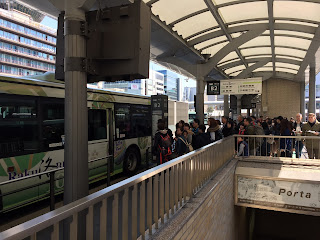I am a bike guy exploring Kyoto - mostly for exercises in many cases though. But on a Sunday in March, I spent a day walking around Kyoto to see places from different angles.
Today, I am writing the walking journey from Kyoto Station to Ginkaku-ji (Silver Pavilion).
Walking on the river bank brings fresh air and relaxing. Does it happen in your city or town? I feel refreshed while walking alongside Kamo River, the biggest one in Kyoto streaming from North to South.
Snowy Mountain and Kamo River
Kamo River
Off the river bank pavement and bike way, Gion is the must to see place as you may see Geishas walking around.
On the way to the traditional dining and entertainment suburb, I walked through a temple called Kenjin-ji. Over there, Geishas were photographed walking around with photographers.
Kenjin Temple
Geishas at Kenjin Temple
Then Gion was just at the corner. I entered the suburb at Gion Corner that is the theatre offering daily Geisha shows throughout the year except some days off. Tickets are available at their ticket office.
Hanami koji Street stretching Gion offers many luxury local cuisine restaurants (ryotei in Japanese) and red flamed street lights keep the street safe at night. Ryotei is the place where VIPs enjoy meals and entertainments, as well as to hold meetings for politicians.
Gion
After walking on Hanami koji Street, I walked on Shijo Street, the busiest street in Kyoto to go back to Kamo River bank footpath. The pavements are packed with horses of tourists at the weekends.
Unique traditional buildings with wooden balconies are the symbol of Ponto-cho, the other side of the river between Shijo Street and Sanjo Street.
You can enjoy foods and drinks at restaurants with wooden balconies from spring to autumn. These balconies are called Kawadoko in Japanese. Not only Japanese cuisines but also western foods are served at the restaurants with Kawadoko.
Restaurants with Kawadoko
Walking alongside the river bank for another 15 minutes, I got off the footpath and walked east towards Heian Shrine. It adjoins the Okazaki Park where flea markets are open occasionally. The shrine is quiet and peace.
Heian Shrine
Having sandwiches with coffee outside a convenience store near the shrine, the next destination was Nanzen-ji Temple. I went through the street surrounded by trees and a small river and a zoo was across the river.
Across the main street called Shirakawa Street, we can see restaurants located along the street and traditional region cuisine of yudofu, putting tofu and vegetables into the boiling water in a pot and taking out into soy based sauce.
Yudofu Restaurant near Nanzen-ji
Nanzen-ji is a quite big and relaxing temple. At the main temple building, you can light incents by kind donations and flow its smoke into your head praying for good.
Nanzen-ji
A traditional Japanese Garden is adjoining the temple (admission fee will be charged), and waterway is on the small hill right to the temple.
My walking journey continued to the north heading to the Philosopher's Path. Surrounding area is peace and calm. In the middle way to the path, another calm temple called Eikando is located. Don't miss out if you go around there!
The south end of the Philosopher's Path is surrounded by a small shrine and trees with benches under trees. It's like a small park. Also you may be able to see cats at the 'park'.
Small Shrine by Philosopher's Path
A small river alongside the path relaxes and calms you. You can sit on the bench seeing the river and resting from a long day exploring Kyoto.
Small River alongside the Path
Also cafes in traditional Japanese buildings are located along the path to relax with coffee or tea, plus restaurants. You might find some lovely presents for your family and friends at one of shops alongside the Path.
Restaurant alongside the Philosopher's Path
Finally you will get to the small street towards Ginkaku-ji (the Silver Pavilion). It's time to see more and more people heading to the temple and who enjoyed seeing the temple.

Busy Street towards Ginkaku-ji
As I had been to the temple before, I didn't get in this time. I just walked around to see how the area was busy. My long walking for day was supposed to end at the sign of the Philosopher's Path. But warm weather made me wanting an ice cream, so I ended up going to a supermarket hundreds metres down the road before catching a bus to Kyoto Station.
The sign of the Philosopher's Path
How do you think about walking in Kyoto? Quite many western tourists do, especially young people. Or are you rather a cyclist? Riding a bike is great in Kyoto. Or do you rely on public transport? No matter how you travel, enjoy exploring Kyoto!
See you next time. Happy planning!!









































